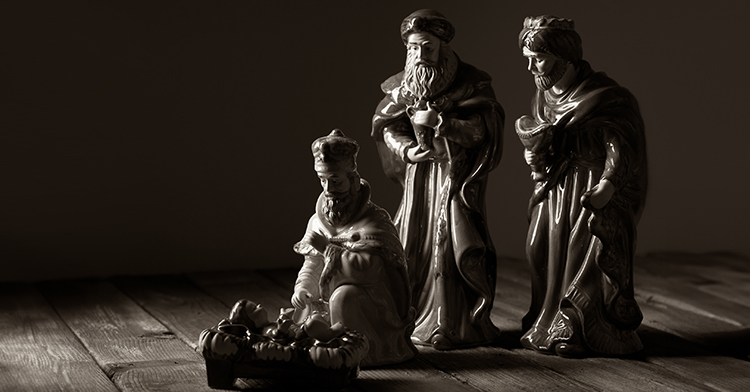A few years ago, an 8-year-old girl attended the rehearsal for the annual Christmas pageant staged during the Christmas Eve family liturgy.
When she realized how cute the pageant was going to be -- adorable angels, cuddly sheep, an orderly manger -- she resisted.
“It’s not cute. It’s not sweet,” she said, and refused to participate. Instead, she wrote a prayer that she shared with the parish after the pageant.
This child’s indignation at the “dumbing down” of the Christmas story showed that she understood the depth of the infancy narratives -- and her ability as a disciple to receive the word of God with dignity.
Church ministers, teachers and parents instinctively recognize the appeal of the stories of Jesus’ birth in the Gospels of Matthew and Luke. They feature surprising news, birth in difficult circumstances, visitors from near and far, and more, all couched in the beautiful, familiar language of readings heard annually in midnight services and Christmas pageants amidst the magic of the holiday season. They appeal to young and old alike, and have images that render these readings accessible to all.
But they are not cute, and they are not sweet.
The infancy narratives are like seeds that contain a concentrated form of the Gospels that follow. As Matthew and Luke mulled over the content of their Gospels, they could work with the events and words from the public years of Jesus’ life. From these grew a deeper and deeper communal understanding of the nature of Jesus and his work.
That understanding, formulated in the 40 to 50 years following the life of Jesus, was then embedded in the infancy narratives. Set at his birth, before his public life, they afforded some freedom to create details to carry their understanding of the meaning of Jesus of Nazareth.
And so the infancy narratives contain hints of the incarnation, the announcement of the kingdom of God, the death and resurrection of Christ, the outpouring of the Holy Spirit, and the gift of the Eucharist -- everything at the heart of our Christian faith.
Titles such as “Christ the Lord” and “Messiah” are used in the infancy narratives, even though the disciples were just beginning to understand Jesus in this way before his death. The Holy Spirit, angels, stars and dreams point to the divinity of Jesus, while his family, the stable, and swaddling point to his humanity. His humble circumstances, in stark contrast to Herod’s, point to the nature of the kingdom of God, while the shepherds and foreigners who visit him proclaim its universality.
These are stories we need to hear again and again -- not just in cute pageants when grandparents can snap photos, but in our classrooms and Bible studies and homes. These stories invite us into the mystery of our faith, to wonder about Jesus’ life on earth -- Did he cry a lot? When did he begin to walk? -- and to ponder the ways in which Jesus is incarnate in our lives today.
A 6-year-old recently brought me this drawing of Jesus with a prayer on the back: “I Pray for Peace on Earth. And the Star to Shine Once Again.” Note that Jesus is not in a manger but on the cross. To his right is the empty tomb with the stone rolled away, and above the cross is a lighter image of Jesus rising. The incarnation, the death and the resurrection of Christ are all represented in this Christmas art, along with a prayer for its peace and light to enfold us all.
This child recognizes the depth of the infancy narratives as more than stand-alone baby stories we have to sit through once a year before we get to the gifts and treats.
In the Catechesis of the Good Shepherd curriculum, children can study, question and reflect on these passages long before they can read, using dioramas and manipulative figures. This hands-on experience of the Gospel allows the text to enter deeply into each child, where it resonates with other deeply known announcements of the faith.
The artwork of these children reflects this process. Some draw the Good Shepherd superimposed on the baby in the manger, the cross instead of the manger or the risen Christ above the manger. Some drawings include the paschal candle and other signs of baptism.
As we approach the annual reading of the Christmas texts, accompanied by traditional carols, gifts and pageants, let us keep in mind both their beauty and their depth, and let us seek to create quiet space and time for children and adults to receive their nourishment.
In a setting such as liturgy, children’s liturgy of the Word or at home before the crèche, a reading of the nativity from the Bible can be followed with a few simple questions, to be answered aloud or within: What does the star (manger, stable, angel …) tell us about Jesus? How did John know to leap for joy? What did Herod fear from Jesus? What kind of king is Jesus? What does the stable (visit of the shepherds, visit of the magi, Bethlehem) tell us about his kingdom? Who is this child?
The weeks of the Christmas season, after the busyness of preparations is over, are a wonderful time to continue to ponder the gift of Immanuel, God with us. Keep your crèche up after you take your other decorations down. Read about the shepherds, the magi, the presentation in the temple and the flight into Egypt. Invite the light of Jesus to spread into the coming year.














